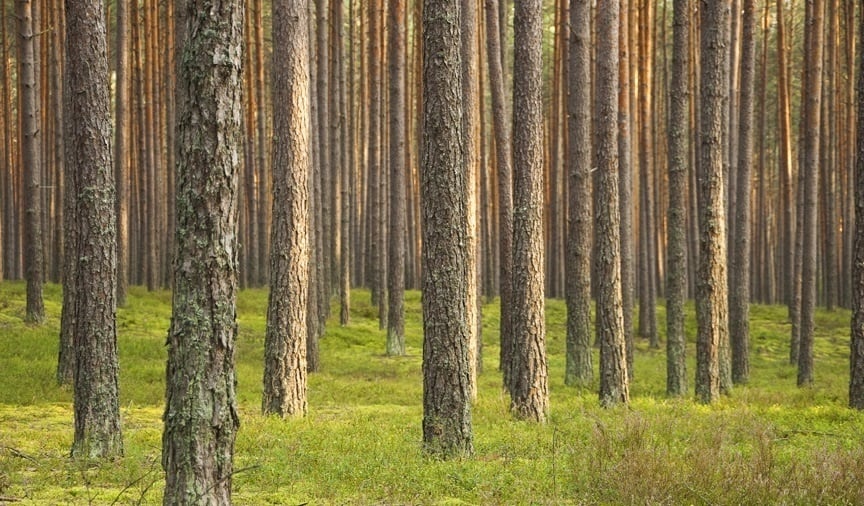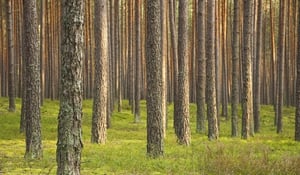
When it comes to mitigating extreme fire risk, optimizing forest management regimes and improving the overall health and value of a forest, the practice of thinning is an irreplaceable tool. Industry data has repeatedly demonstrated that private forestlands suffer fire damage at a much lower rate than public forests, which is due in part to active forest management (including thinnings) performed by private landowners.
There are a number of budgetary and logistical challenges to maintaining millions of acres of public forestland, but the US Forest Service (USFS) understands the value of thinning as well, which is why the practice has increased within national forests over the last decade. While criticism from the extreme fringes of the environmental movement continues, thinning national forests can oftentimes be a positive point of compromise.
- Per a recent article in The White Mountain Independent in east-central Arizona, a cooperative thinning project is yielding positive results. The article discusses the White Mountain Stewardship Project, which thinned 50,000 acres over the course of 10 years with the assistance of the USFS. The article notes that “…the thinning projects completed are credited with saving Alpine and perhaps Springerville from the Wallow Fire.”
The article continues, “Environmentalists, conservation groups and local officials have all united behind the idea of thinning the [Coconino National] forest to not only reduce the threat of catastrophic wildfires, but improve conditions for wildlife. The ponderosa pine forest of Northern Arizona are adapted to frequent, low-intensity wildfires. But a century of fire suppression, grazing and logging have left them dangerously overcrowded with trees.”
- Another recent article published by KOTA TV in Rapid City, IA describes a USFS-led thinning taking place in the Black Hills National Forest. The area has received ample precipitation this year, which created a good opportunity for local foresters to get into the woods and do some of the maintenance work they wouldn’t normally be able to do this time of year.
“In the Forest Service Mystic District near Rockerville, the firefighters are working to thin out some of the fuel load in a patch of the forest. They are thinning what they call ladder fuels, the smaller trees that can catch a ground fire and then take it up into the upper canopy and possible cause a catastrophic crown fire. By knocking the trees down to the ground, and if, or when, a fire moves into the same area, it would slow, giving firefighters more time to contain it.”
As advocates for healthy, working forests, we have long promoted the many benefits of forest thinning, which include:
Increased Growth
Private landowners have demonstrated repeatedly that properly managed, working forests have both economic and ecological benefits. Regular thinnings provide an improved environment for maximizing a site’s growth potential, which results in larger, healthier trees and higher value timber. As a silvicultural practice, thinning allows for the continued growth of the healthiest preferred species within a timber stand while removing the suppressed, diseased and low-vigor trees that will impede the growth of the entire stand. Many of the low-vigor trees in such stands continue to grow at a reduced rate until competition claims them or they are removed via thinning. An integral piece of properly managing the forest is the removal of these trees, which can also serve as unnecessary fuel load during a fire event.
Improved Utilization
While the economic benefits of regularly removing suppressed and dying trees are minimal, intermediate thinnings do pay for themselves and provide the economic advantage of improving the health of the entire timber stand. Arranged thinnings during growth cycles will yield wood that can be utilized for pulp, chip or pellet operations while increasing the value of the overall stand.
Reduced Vulnerability to Disease and Insects
Maintaining proper stand density is essential to preserving tree health and reducing tree damage from both disease and insects. As a rule, healthy trees are less susceptible to insect infestation than unhealthy ones. For example, the Southern Pine Beetle (SPB) is the most harmful insect to forests in the US South, but such pests are not only limited to pine trees in the region; the US West and British Columbia (BC) are still reeling from a Mountain Pine Beetle outbreak that began in the early 1990s. This insect has since killed roughly 50% of the total volume of commercial pine in the province of BC.
Loblolly and slash pine in the US South are also particularly susceptible to certain diseases that flourish in unmanaged forests. Annosum root rot is the most common of these diseases and once a tree in the stand becomes infected, the disease spreads to adjacent trees through root contact. In a dense forest, the root systems of the trees are intertwined providing an easy pathway for this disease to spread. As these systems deteriorate, the trees die and gradually fall over due to lack of support.
Genetic Enhancement
Genetic enhancement can also be achieved through proper and regular thinning. Trees removed in thinnings are usually inferior, diseased or have objectionable shape, which is sometimes due to genetics. By removing such trees early and prior to forest regeneration, the landowner or land manager can minimize the number of trees with undesirable traits in a stand.
Environmental Benefits
Thinnings will alter the environment of the forest, which promotes increased growth. Thinnings allow the penetration of light, which increases the temperature of soil as well as the availability of moisture and nutrients within the soil. With these changes, forest vegetation flourishes and produces a more favorable habitat for wildlife. Thinnings will invariably reduce the canopy of the forest, which allows a greater amount of rainwater to reach the forest floor as well.
Forests across the globe also sequester enormous amounts of carbon but increasing fires and insect infestations continue to kill trees at a quickening pace. An effective way of preventing this from occurring—and of maintaining forests as invaluable carbon sinks—is to manage these forestlands for sustainability, productivity and health.
Thinnings and Fire Prevention
While Mother Nature has used fire to control forest growth for eons, managing the damage and mitigating the risk that extreme wildfires pose to communities is a challenge that must be addressed. The best available science (and experience) tells us that proper thinnings and controlled burns are the most effective ways to minimize fire exposure.
A 2015 article from the American Forest Foundation (AFF) noted that “A recent study by The Nature Conservancy and the U.S. Forest Service showed that a 12,000-acre ‘doughnut hole’ within the Carlton Complex fire zone remained untouched by the inferno. The area survived, the researchers believe, because it had been previously thinned and burned. They say that 9.5 million acres of Washington and Oregon forests would benefit from the same management that protected the doughnut hole.”
Thinning is an important silvicultural practice that increases the growth potential of the forest as well as the return on investment with higher-vigor and higher-value trees. An unmanaged forest is oftentimes an unhealthy forest, as well as a potentially dangerous tinderbox of wildfire fuel. It is a promising sign that some communities in the western US are able to move past the divisiveness and thin their forests, which is in the best interest of the communities that live, work and play among them.





